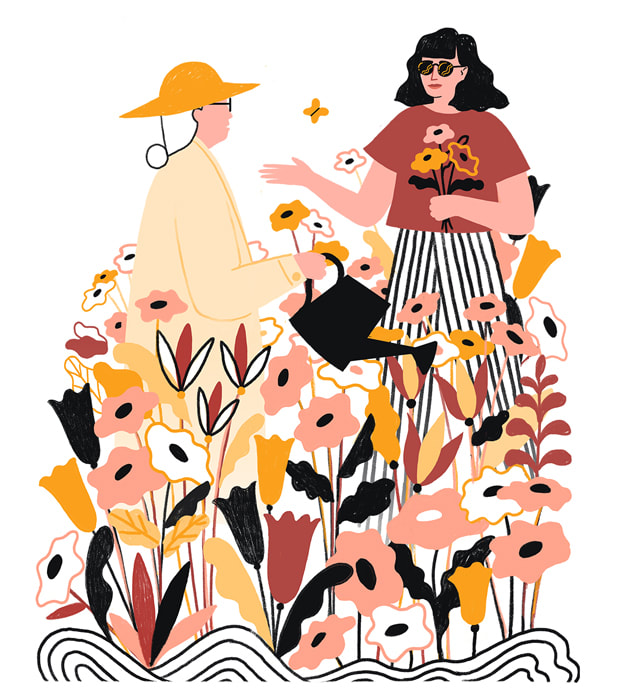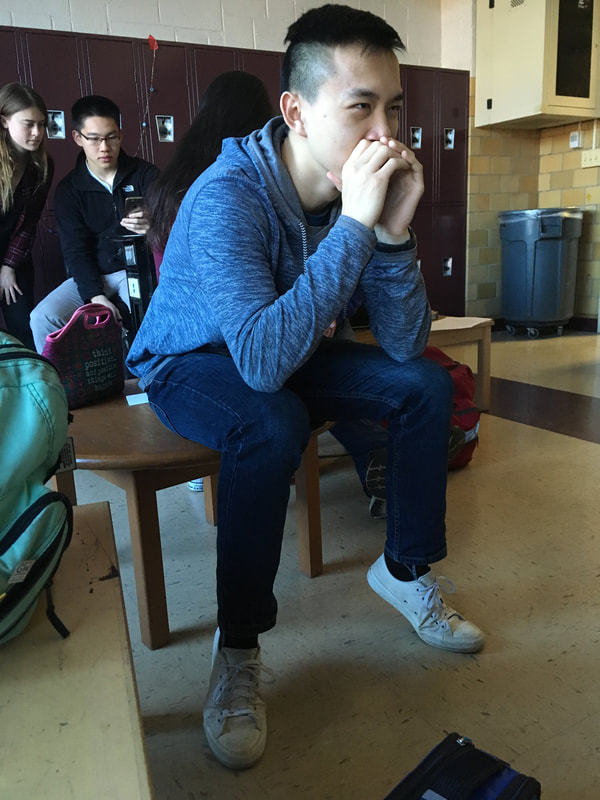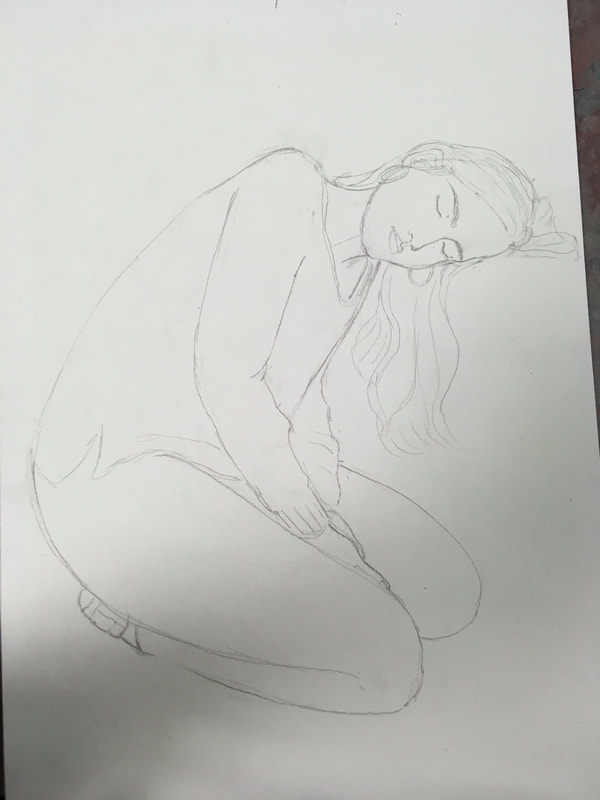Eisenman explores the human experience with a wide range of mediums, stating "I want my work to be authentic and reflective of my body, what it's interested in." She takes influence from Expressionism, Impressionism, and Pablo Picasso. Much of her work are expressionistic portraits of herself and her friends, or based on her observations of her life and culture. A lot of her content is inspired from comics, pornography, and feminist historical figures that challenged sexism and pop culture. Her large paintings records everything from small, daily incidents to complex fictional scenes. Her work does not distinguish between the personal and the political, meaning her autobiographical scenes can also be read as social commentary on a variety of topics, from queer issues to being a struggling artist in a capitalist system. Links:1. Eisenman speaks about her work, video. 2. Article 1 (about femininity and queer politics) 3. Article 2 (about fluid art styles) Reactions:1. This video is Eisenman speaking about her relatively recent foray into a new medium. Although a new medium, it still connects to her old work because it's still focused on the human figure, but in this medium she is able to physically touch the subjects. I really liked the statement about how the "dance with the material" in sculpting bodies has an intimacy that painting doesn't. I particularly enjoyed the connection this new medium had to her old work, and it developed my knowledge on "jumping" mediums.
2. I really, really enjoyed the part of the article about not separating from the autobiographical and the political. I feel like there's often a false dichotomy drawn between personal and political, and I appreciate how her work shows that many times, it is impossible to separate the two. 3. This article highlights how Eisenman jumps back and forth among very different styles. Her work ranges from cartoon figures to photo-realist exactitude. I hope to develop my own body of work to reflect such a wide range of styles in the future.
0 Comments
 While I was not able to make it to the Lunchtime Lecture in person, I was able to learn a great deal from the video taped of the lecture uploaded onto Facebook. A lot of the recent works Freyer has engaged in, like "Free Hot Supper," are a lot tilted toward the "social practice" side of social practice art than anything I had been exposed to before. A lot of his work is also influenced by his past with substance abuse, and I really enjoyed seeing how he incorporated this in an extremely nontraditional way. A piece of his that I thought was especially interesting was the Free Ice Water Project, where two people sit down and have a conversation, sharing a jar of ice water, about turning points in their lives. At the end of the conversation, the two people put a token into the jar and fill it up with water. I thought it was extremely interesting how this jar could become a physical manifestation for a temporary conversation. It made me think a lot about how a lot of art is made in the chase of solidifying temporary moments, but Freyer's work is especially reflective of this. I think I want to incorporate this idea into my work and deal with the temporary.
Lossing is influenced by her background in screenprinting and love for textile design. Her process begins with a rough sketch in Photoshop, and uses layers to build her work up into a more finalised drawing. Then, she chooses a color palette and through trial and error settles on a scheme. Lossing describes her style as shape based and simple with a focus on the human form, limited color palettes, and nature inspired motifs. She takes inspiration from Matisse. Her work seeks to depict simple shapes and ordinary humans in hopes that her audience sees themselves in the art. Links:Reactions:1. I really enjoyed reading this article. I especially liked the part of the article detailing her process. Lossing says sometimes ideas come naturally while others are more laborious. She also mentions that although a lot of her work is dictated by her client, she notes the importance of being true to yourself and dedicating time for personal work.
2. This article is rather short, and briefly details a general summary of Lossing's work and biography. What makes this article especially valuable is the work attached to the end. I would not have encountered this work otherwise. You can especially see Lossing's background with patterns and background design here; each work has layered patterns and it's interesting to see how the objects interact with each other. 3. This interview got me to really think about other careers as artists. My most common perception of working artists are those with gallery representation or big canvas work. However, this interview really opened my eyes to how artists make money by working freelance. Every new art movement comes with a reactionary group of protestors claiming that it's not /real/ art. Social practice art, I believe, is no exception. We've seen this story played out time and time again. Social practice art is just the newest thing for critics to berate, and I believe that in a couple of decades, this movement will become part of the greater art lexicon the same way Impressionism is. Art that pushes boundaries, especially if that boundary is the question of what exactly art is, will always discomfort. However, social practice art presents a series of new challenges unique to its purpose and style.
It goes beyond social practice art. It's all contemporary art. Just take a look at student attitude of contemporary art in the microcosm of MLWGS. The amount of times I've heard things akin to "I could do that" when talking about semi-modern art movements like abstract expressionism is bizarre. I think, as usual, the best way to approach an explanation of this disconnect between contemporary art and the public (in regards to the question of what constitutes art) is to look at some history. In the 1800s, the Impressionists were initially regarded as untalented artists who were needlessly pushing the boundaries of art. The idea of visible brush strokes and the inclusion of the artist’s own perceptions and experiences had been unheard of, causing the style to face harsh opposition from the conventional art community of France. In the present day, Impressionist work is showcased right next to the Old Masters. Every subsequent art movement following Impressionism, all of which extended the definition of art in some way, has received backlash from the audience. In their contemporary times, Cubism looked too primitive, Dadaism was too simple, and Precisionists were too stiff, but now these artists are displayed in national galleries. It’s almost cyclical in its nature - a group of modern artists push the boundaries of art, conventional critics and community rail against it, fifty or so years later the movement is praised to have produced beautiful and new art. Applying this pattern to the modern day, I think we’re just too close to see the bigger picture forming. So social practice art. Members of the traditional art world are acting the way their historical counterparts did: reactionarily. Maureen Mullarkey, a NY painter, wrote "that art is increasingly not about art at all" and that is it "fast becoming a variant of community organizing by soi-disant promoters of their own notions of the common good" (7). Undoubtedly, social practice art is distinct. Aesthetic takes a backseat to more egalitarian purposes. It presents a host of new challenges; traditional museums have difficulty displaying such art within their own institutions (5). But with it, I believe, it presents a host of new benefits. I've always believed art has been inaccessible to members of the non-wealthy human population (call it controversial, but art is an indisputable luxury that requires excess time, and increasingly, knowledge of history to be able to enjoy; I use non-wealthy as a descriptor for those who do not have to worry about food being on the table). However, social practice art is able to reach outside of this base demographic. For example, a private institution founded by Emily Pulitzer that staffed two full-time social workers who helped former prison inmates and homeless veterans as part of a curatorial program was able to reach out to the poor and create real change for non-aesthetic reasons (6). In the end, social practice art will absorb into mainstream art and carve a place for itself in the world, and the definition of art will be pushed again by another movement. But for now, it's just a waiting game until that day comes. My home project is going very slowly. It is taking an obnoxious amount of time for the gold on the waves to dry. And the way I'm doing it makes it so that I have to wait for a bunch of it to dry before I can do more.
My in class project, though, is going along a lot faster than I thought. It only takes me a day to get a sketch and outline. I took this picture of Max this week and I'll sketch it at another time. I took this nice picture of Josh to use as a reference for my new oil painting. And I did this nice outline of Mackenzie to continue my project I started in like November. Overall things are very nice.
The lunchtime lecture held by Sasha Freyer was part autobiographical and part a lesson on the basics of the basics of experimental film. This was extremely different than the speech Kirk O'Brien gave a couple of weeks ago. She talked a lot about the duality between "day job" and independent artistic ventures. I really liked being exposed to a new artistic medium. Film has not been something that I've explored. I was especially moved by her experimental films, which is the playing with the medium of film as an artistic medium the way painting is. Experimental film organizes shots the way poets organize words, but you can't come to it expecting narrative fiction. I really liked the way she phrased it: it's a mix of "painterly attention to color and form combined with poetry." Her process of adding color to black and white archival film was extremely interesting to witness as well. Overall, being exposed to a new artistic medium was very enlightening. Additionally, seeing a successful artist who makes a living doing art was actually pretty inspiring. I wasn't aware of how willing the government was to give out grants to artists, and it makes the career seem less lucrative.
This project is a lot more time consuming than originally anticipated. My process was using the picture I took of Julia and outlining it onto the canvas. I blocked in the highlights and shadows. I chose pink/tan as the color base. I painted each of the colors on, trying to make it as smooth as possible. The hair was a bit of a challenge, but after reassurance from multiple people, I decided to just leave it as it is.
Started a new ~home project~! I'm always super excited at the start of a new project. Everything has potential and the crushing weight of imminent failure has not set in yet. I'm very, very excited about this piece in particular, though, because it's the largest I've ever done. The background is also a step up from my usual backgrounds. Usually I've done just solid color, but now I'm making the background an integral part of the actual piece. Things are looking up! But check in with me in a couple of weeks and I'll be sure to be complaining.
I took the picture I'll be using for my in class project. I plan on continuing with my ~journey~ exploring blocking in colors of the face rather than blending. I know I want the content to be similar to my last project; something about needing to look happy/presentable. I'll work out the kinks later.
|
AuthorWrite something about yourself. No need to be fancy, just an overview. Archives
March 2019
Categories |


















 RSS Feed
RSS Feed
